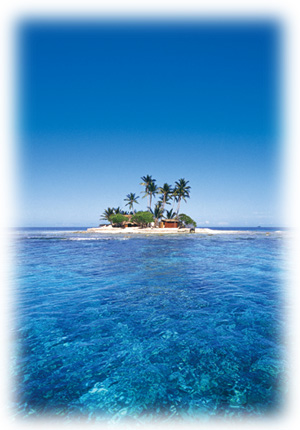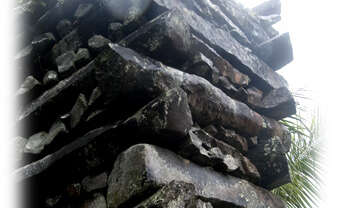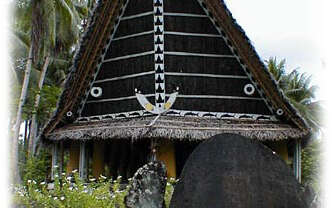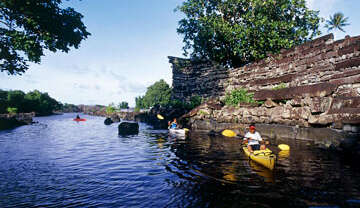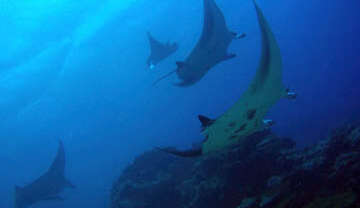Beaches, Parks & Ruins in Micronesia!
James Palsis Marine Park (KOSRAE)
The James Palsis Marine Park offers visitors a look at some of Micronesia’s most pristine forests, mangrove and lagoon and sea-grass meadow ecosystems. Located between Tafunsak and Walung villages the Park is a community-based conservation area, recognized by the people and state of Kosrae for its outstanding and sustainable biodiversity. One may snorkel in crystal clear, 83 degree F waters over colorful reefs teeming with life, or stroll along the isolated beaches near Walung Village, which is only accessible by boat, or for the real adventurous, by foot over jungle trails forged by wild boar hunters. At the entrance to the Park, one may unwind at the newly completed picnic huts and have a BBQ, or just unwind and enjoy the aqua-blue waters moving in and out and the gentle breezes that consistently waft through. Toilet facilities and water available.
Utwe-Walung Marine Park (KOSRAE)
The Utwe-Walung Marine Park offers visitors a look at some of Micronesia’s oldest and most diverse mangrove forests, as well as a series of highly unique deep marine lakes, small islets, and back-water mangrove channels. Located between Utwe and Walung villages the Park is a community-based conservation area, recognized by the people and state of Kosrae for its outstanding and sustainable biodiversity. In 2005, the area was designated as the first UNESCO Biosphere Reserve in the Pacific. Take a canoe tour through the channel that runs the length from Utwe to Walung villages. You’ll be amazed at the natural wonders and peaceful solitude of this vast area.
Ruins in Micronesia
Nan Madol (POHNPEI)
Nan Madol consists of 92 separate islands covering 222 acres (90 hectares). Much of the ruins still remain in the form of enormous basalt “logs” assembled into walls and buildings. Nan Madol, the capital during the Saudeleur Dynasty, was also the center for politics and religion. It is said to have been constructed between 500 and 1500 A.D. It included the residence and tombs of the royal family, servant quarters, a guest house for visitors, and separate islands for funerals and storage. However, complete surveys have yet to be conducted, so many of the details are still a mystery, and that mystery is how these huge stones – some weighing more than two tons – were quarried, transported and finally assembled into what has been referred to as the “Venice of the Pacific”.
Pohnpaip Petroglyphs (POHNPEI)
Pohnpaip (Pohn=on top of) (paip=large rock) is about 5 meters in height with a gently sloping surface covering about 30 square meters. Petroglyphs including a sword, the sun, the moon, people, fish, and human footprints are scattered about the surface. While the creators of these Petroglyphs are unknown, it is believed that they were carved long ago by visitors from another land.
Lelu Ruins (KOSRAE)
Considered one of the wonders of the Pacific and once an ancient ruling empire complex of the entire Micronesian region, a similar version of this ruin were replicated later in Pohnpei (Nan Madol) and other islands in the Pacific. Huge basaltic slabs arranged in order, making 20-ft walls that encompassed a capital city of Kosrae in the ancient times. In fact, if the fabled stories of Lois Becke – Trader, Journalist, Writer and the famed 19 year-old Super Cargo for the legendary pirate, Bully Hayes – are to be believed, the Lelu Ruins were an active ruling metropolis through the latter part of the 19th Century. The genesis of these ruins of large basaltic walls, channels, streets, tombs, and living quarters dates back to the 13th century.
Menke Ruins (KOSRAE)
Holds the temple of the Goddess of Breadfruit, Sinlaku, where she spent her last days before fleeing to Yap before the arrival of the Missionaries in 1852. The Menke Ruins are otherwise considered – according to famed, Visiting Archaeologist to the FSM, Dr. Felicia Beardsley – as the oldest such ruins in FSM, and perhaps even the entire Micronesian sub-region, pre-dating both the Lelu Ruins in Kosrae and Nan Madol in Pohnpei. What is perhaps the best feature of the Menke Ruins is the Menke Valley itself, which holds the pure and untrammeled Menke River and one of the last two stands of Terminalia Carolinensis (known as “Ka” in Kosrae forest in the world. The hike itself is an excellent way to enjoy the best natural beauty that the high islands of the Caroline archipelago offer.



